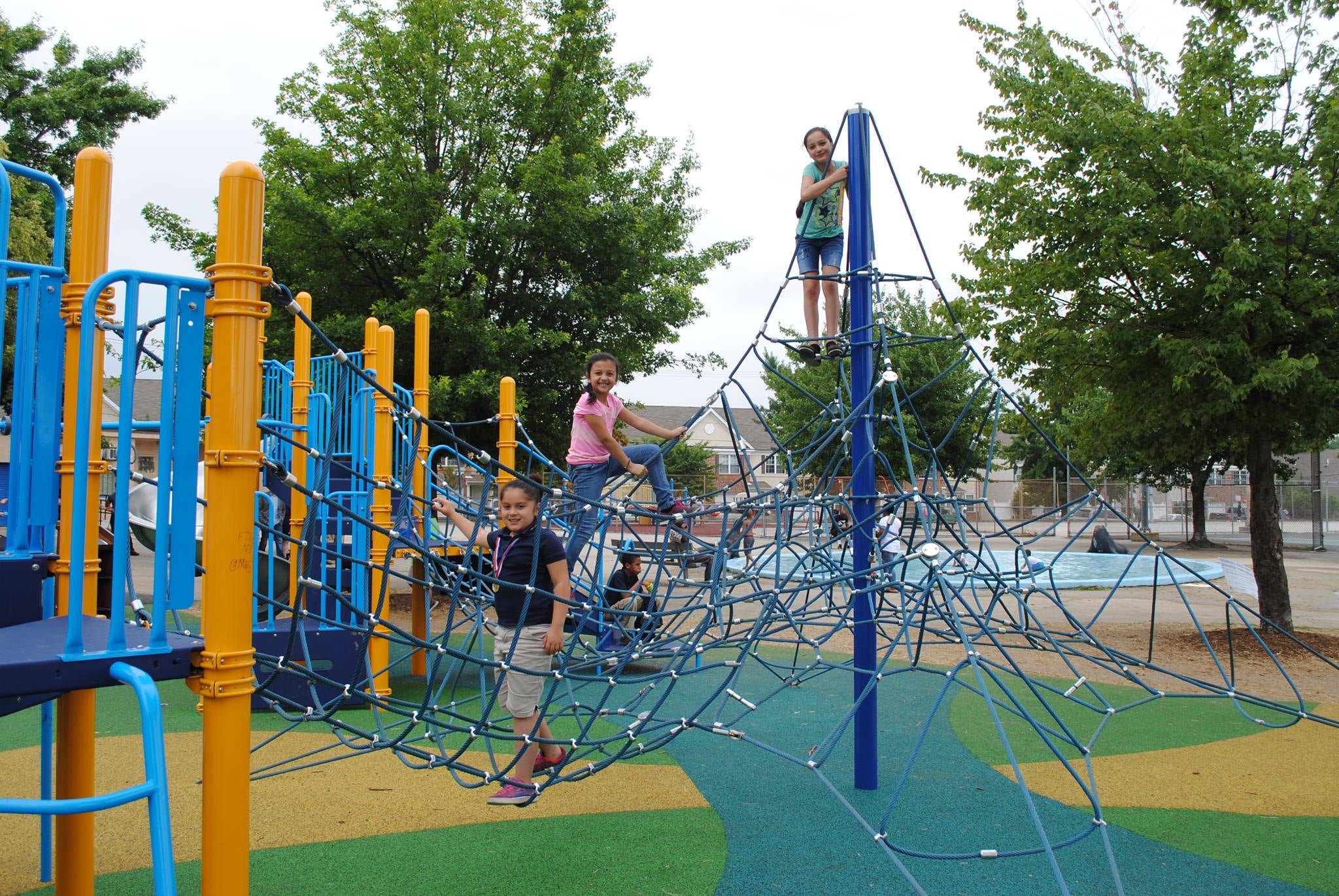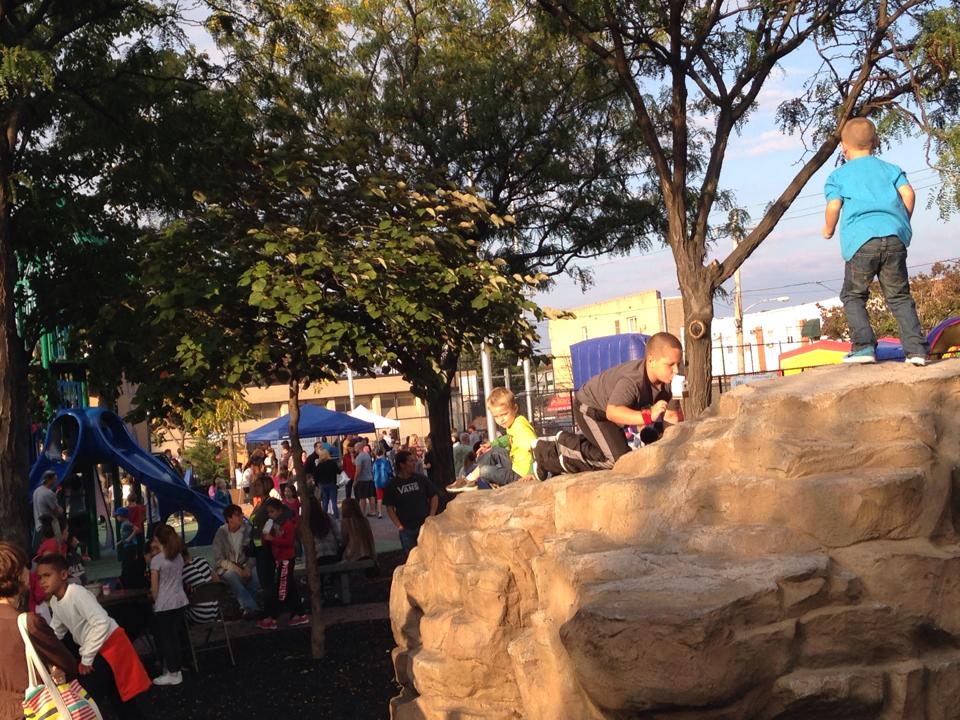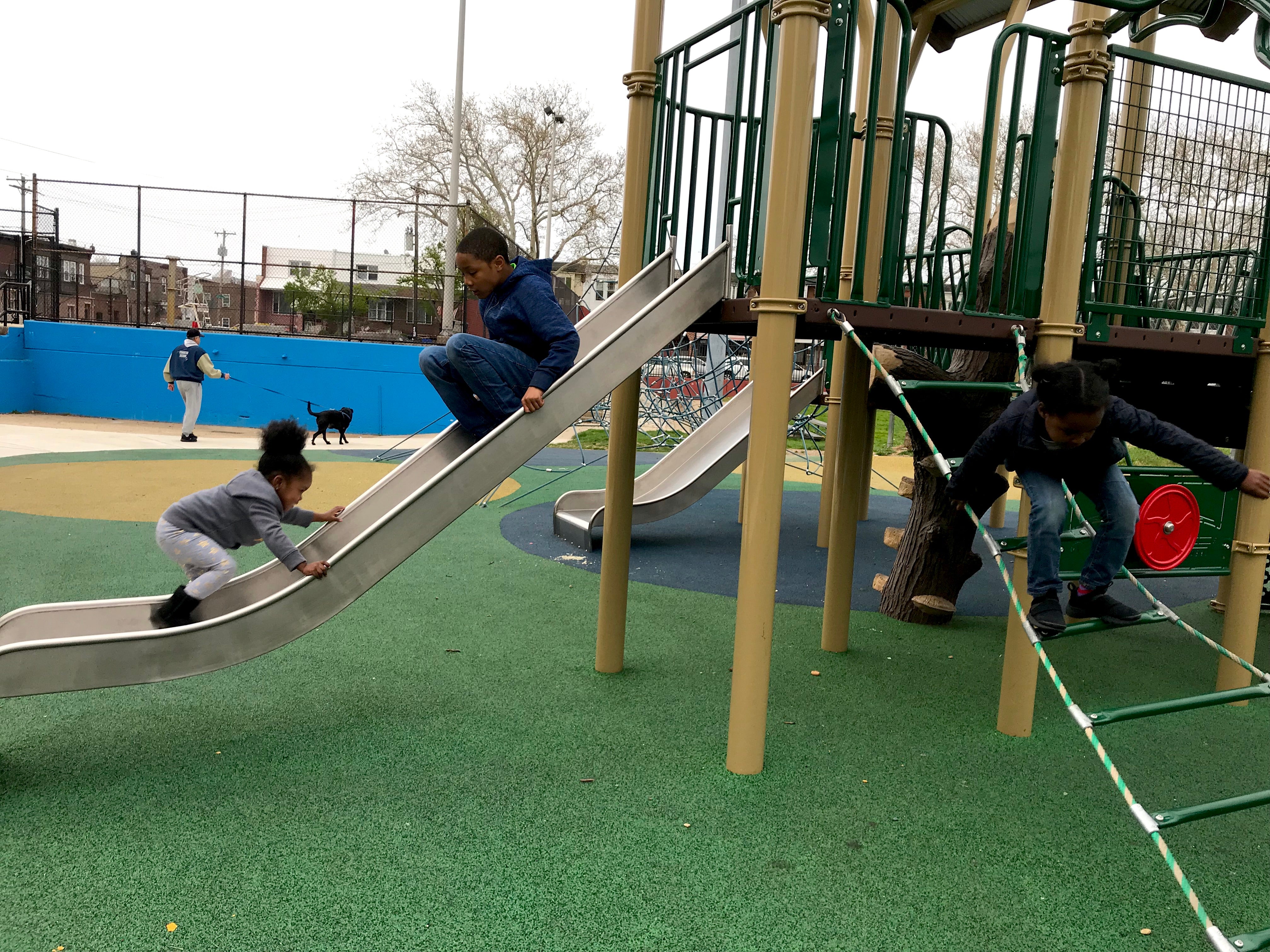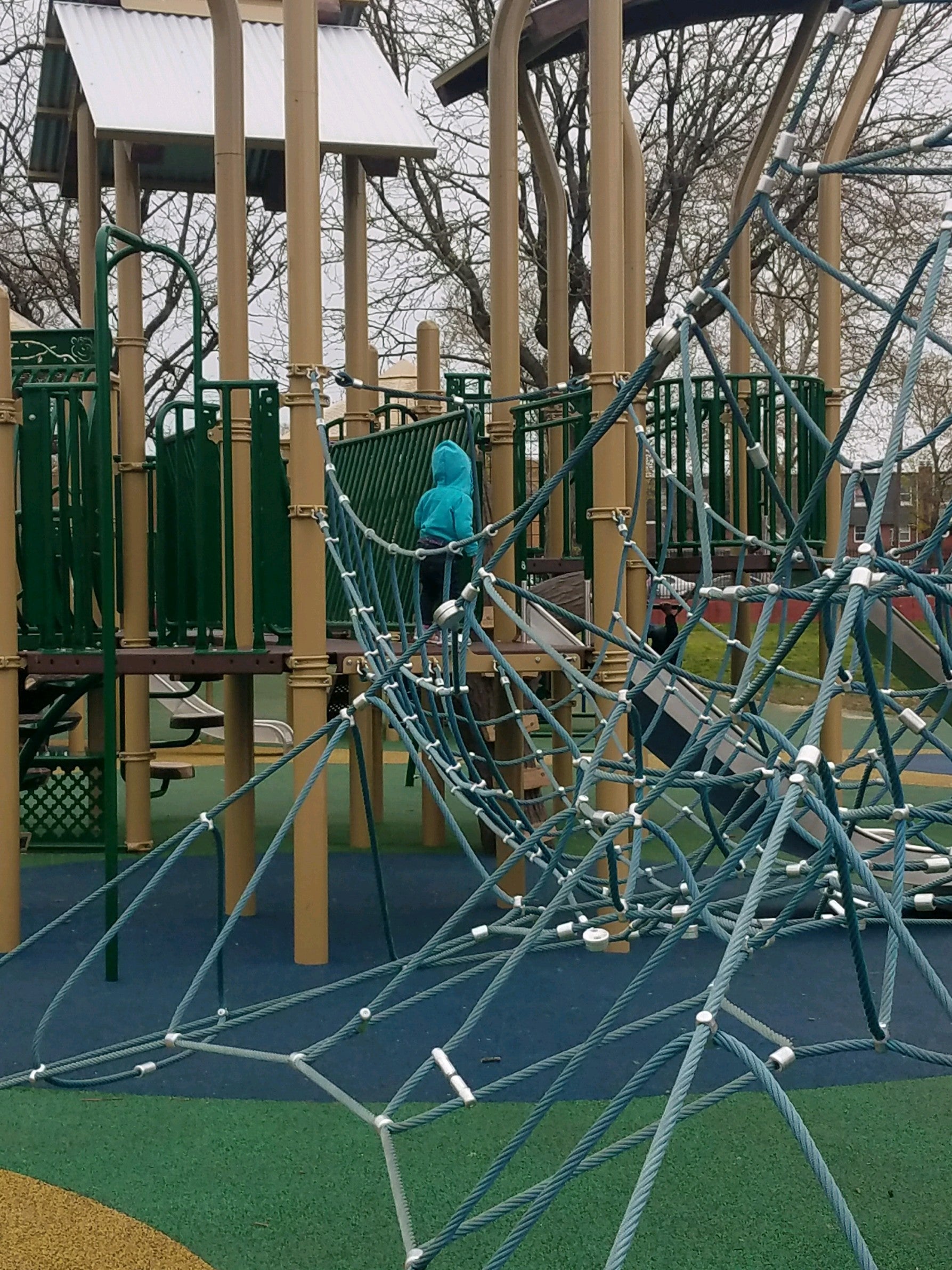Philly’s next generation of playgrounds is here and everyone is invited in

When it comes to places to play, the notion of proximity and convenience are two very different realities for South Philadelphia mother Kelly Palange. A few blocks away from her home is Marconi Plaza, a 19-acre park with a mid-sized playground that is literally divided in half by Broad Street. Within earshot of cars speeding toward the sports stadiums, Marconi is not exactly kid-friendly, in Pelange’s eyes. “There’s glass all over the place. The concrete is crumbling. The kids are constantly falling down where the trees are busting through the cement,” Palange says. “It’s a mess.”
It’s a perfect spring Sunday, and Pelange has instead traveled to Burke Playground in Pennsport, more than a mile away, to find a safe place for her son to blow off steam. It’s their first time here. Usually, they’re traveling further, nearly into Center City, but now the newly renovated Burke has emerged as a “convenient” option. “It’s big enough. I can see my kids from all angles, and it’s fairly clean. I’m into it,” Palange says of Burke on first blush. “Except for that luscious smell of cigarettes,” she adds, an odor emanating from the fenced-off street.
The South Philly mom isn’t the only person applauding the changes at Burke, one in a series of new playgrounds across the city designed to be more inviting for children with disabilities — and seemingly succeeding. Although none of the parents I spoke to identified their child as having a disability, the space was full of different languages and ethnicities and felt more welcoming and safer than your standard Philly jungle gym. The site lines are low and exits to the street limited and clearly marked. Soothing colors, a mix of textures, and panoply of sounds abound. These are details that blend into passersby but stand out in research on the best forms of play geared to children with learning disabilities like autism.

The power of “subtle changes”
More than five percent of school-age children in the Philadelphia metropolitan area have a disability, according to the 2010 census. While the Americans with Disabilities Act (ADA) and other federal regulations require cities like Philadelphia to proactively increase accessibility at public facilities, including playgrounds, there’s been a recent push to move beyond the mere letter of the law. “The ADA is the minimum, but it does not cover all disabilities like autism that require specialized design solutions,” says Alain Joinville, spokesman for the Philadelphia Department of Parks and Rec (PPR).
It’s a problem the city is now working to solve. Since 2016, when City Council passed an “inclusive parks and playgrounds bill” more than a dozen playgrounds have received upgrades geared towards the recreational needs of children with disabilities, along with intergenerational populations. The playgrounds include Wister Playground in Germantown, Cione Playground in Kensington and Burlholme in North Philadelphia.
These projects aren’t the only signs of progress. Mayor Jim Kenney’s new ADA coordinator, Daniel Lopez Jr. helped build accessible playgrounds in El Paso, Texas before joining the administration earlier this year. And with the city’s highly anticipated Rebuild initiative in the pipeline — a $500 million plan proposed by Mayor Jim Kenney to improve parks, rec centers, and playgrounds — Philadelphians can expect to soon find themselves with more play options for children with disabilities.
Still, change on the ground can feel slower for parents of children with disabilities. Last year, PlanPhilly wrote about Mandy Lin, a mother in Chinatown who regularly makes a three-hour round trip journey to the Christian Street YMCA on weekends, just so her son, who has a learning disability, can attend a swim class that accepts him. “We’re trying to say we have a right to go to our neighborhood parks and rec centers and they shouldn’t turn us away,” says Anna Perng, a disability-rights advocate who’s been testifying in front of City Council since 2015. There’s a need for new facilities, but Perng says that’s only part of the problem. “We can raise the money to make the physical improvements, but we can also make sure the parks and rec centers staff have the support and training that they need so that if an autistic child comes in, and they’re running a swim class, they know how to include and support that person, instead of saying, ‘you should really go to Carousel House. Those people will know how to support you.’”
Awareness of these issues is growing in City Hall, Perng says, and Bass’s bill serves as one more step in the right direction. Thanks to the 2016 bill, every renovation or new construction of a city-owned playground or park must include elements like “sensory play equipment,” “adaptations for the blind and visually impaired,” and apparatus for those in wheelchairs. “It doesn’t really make a difference whether Philadelphia is ADA compliant if there are children and adults in our city who can’t even work out or play on a [public] playground,” Councilwoman Cindy Bass, who introduced the inclusive parks and playgrounds bill, wrote in a statement to PlanPhilly.
Bass began to realize the need for the city to design its playgrounds differently years ago, after visiting Champions Park playground in the Northeast. “Small things like colors and textures made the playground more welcoming to children with developmental delays and disabilities,” Bass recalled in a recent interview. “It really struck me that subtle changes could make such a big difference and enable children who may have autism, for example, to enjoy our public spaces as much as any other child.”
Playgrounds can play an essential role in childhood development, although for children with disabilities, the experience can be delicate. Research has shown that a visual and sensory landscape can trigger negative emotions, in addition to the upsides, either due to an overwhelming or under-stimulating experience that a child, say one with autism, might have. Spatial design impacts whether or not playgrounds are an inclusive asset for everyone.
Catching up to the suburbs on inclusive play
In Pennsport, the playground at Murphy Rec Center offers a lot more than swings and slides. A variety of spinning and climbing features spread out across a soft synthetic ground surface. Kids can choose between ample sound-inducing apparatus, or stick to quieter areas designed for retreat in case of overstimulation. Some of the most challenging equipment is grouped with the more intuitive items, encouraging social interactions between kids of different ages and abilities.
“There are all these ropes for kids to climb and lots of room for them to play freely without getting hurt,” said Tiera Laws, a Point Breeze resident who was enjoying the park on a recent afternoon with her niece and nephew, Lauren and Lamaj. “I’ve seen kids with special needs here before and they seem good like they are having fun.”
In the past, often families would have had to leave the city to find such a safe and welcoming place to play. They would have likely found themselves at Oxford Memorial Park in Oxford, Pennsylvania, a borough of 5,000 people in Chester County. The playground is a regional attraction, with new state-of-the-art equipment designed for children with disabilities including a wheelchair-enabled swing, an interactive puzzle written in Braille, and unique sensory stimuli for children with autism. Supported by more than $150,000 of fundraising from the local Rotary Club and local businesses, including one who donated excavation services to get construction going, the park testifies to the community buy-in needed for such extensive park redesigns to succeed. A small sign at the park recognizes the community volunteers who installed its equipment.
While the playground has been celebrated by advocates of children with cognitive and physical impairments, it fits a pattern that’s all too familiar for urban families. When it comes to inclusive playgrounds, the best of the best tend to be located in more affluent suburban communities rather than cities like Philadelphia where many disabled children grow up in poverty. s. And a lot of the most famous examples in the region, including the nationally recognized Jake’s Place in Cherry Hill, often rely on the aid of private foundations. After all, these playgrounds are not cheap. “A facility the size and scope of the Cherry Hill Jake’s Place can cost as much as $600,000 to build,” the Inquirer reported.
But in Philadelphia, Bass, chair of the city council’s committee on parks, recreation, and cultural affairs hopes this is just the tip of the iceberg. “This bill really came at the perfect time because it was signed into law right around the time that Rebuild was announced,” Bass said.
Equity and inclusion are two of the guiding principles behind Rebuild, and the initiative comes with its own enforcement mechanisms to ensure that playgrounds meet inclusive play guidelines.
“The nonprofits managing Rebuild projects will be given design guidelines, which will include an emphasis on creating spaces that are inclusive,” said Kira Strong, deputy director of design and construction for Rebuild. “It will be their responsibility to ensure that designs are inclusive; however, the City will also have to sign off on all designs before a project can move into construction – that means making sure they are inclusive, meet department standards, and reflect the input of neighborhood residents.”
While the large budget for Rebuild beckons neighborhoods to imagine ultra-accessible playgrounds in Philadelphia that are matching or exceeding the likes of suburban wonderlands like in Oxford, the city can’t say exactly what each corner of the city can expect. But one outcome of Rebuild might be the development of a plan to build more inclusively, without worrying about wealthy benefactors. “it doesn’t cost any more to group noisy activities together and quiet activities together to give kids choices about how much sensory stimulation they’re getting,” said Strong. “A big part of it is awareness and thoughtfulness during the design process. It is important to note that making parks and playgrounds more inclusive doesn’t necessarily make them more expensive.”
Philadelphia’s Inclusive Playgrounds
Gorgas Park — 6300 Ridge Avenue
Burke Playground — 200 Snyder Avenue
Ford Playground — 609 Snyder Avenue
Murphy Rec Playground — 300 Shunk Street
Cione Rec Playground — 2600 East Aramingo Avenue
Marian Anderson Rec Playground — 740 S. 17th Street
Smith Playground — 2100 S. 24th Street
Nichols Park Playground — 5430 Race Street
American Legion Playground — 6201 Torresdale Avenue
Fairhill Square Park Playground — 2601 N. Lawrence Street
Hissey Playground — 400 E. Indiana Avenue
Piccoli Playground — 1501 E. Bristol Street
Wissinoming Playground — 5801 Frankford Street
Wister Playground — 4971 Baynton Street
Burlholme Park Playground — 7370 Central Avenue
WHYY is your source for fact-based, in-depth journalism and information. As a nonprofit organization, we rely on financial support from readers like you. Please give today.






